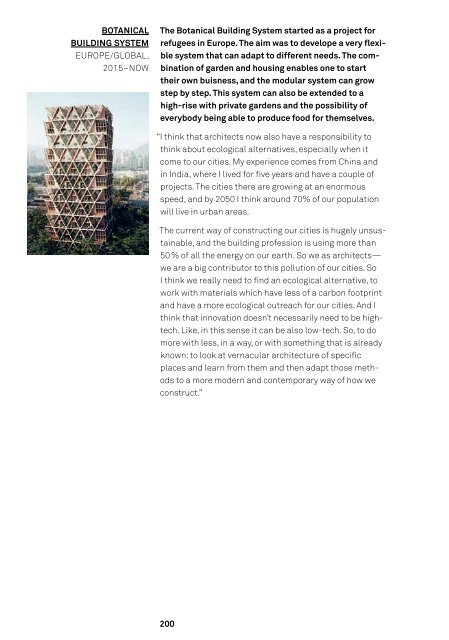HORTITECTURE The Power of Architecture and Plants
ISBN 978-3-86859-547-5 https://www.jovis.de/de/buecher/product/hortitecture.html
ISBN 978-3-86859-547-5
https://www.jovis.de/de/buecher/product/hortitecture.html
Create successful ePaper yourself
Turn your PDF publications into a flip-book with our unique Google optimized e-Paper software.
BOTANICAL<br />
BUILDING SYSTEM<br />
EUROPE/GLOBAL,<br />
2015–NOW<br />
<strong>The</strong> Botanical Building System started as a project for<br />
refugees in Europe. <strong>The</strong> aim was to develope a very flexible<br />
system that can adapt to different needs. <strong>The</strong> combination<br />
<strong>of</strong> garden <strong>and</strong> housing enables one to start<br />
their own buisness, <strong>and</strong> the modular system can grow<br />
step by step. This system can also be extended to a<br />
high-rise with private gardens <strong>and</strong> the possibility <strong>of</strong><br />
everybody being able to produce food for themselves.<br />
“I think that architects now also have a responsibility to<br />
think about ecological alternatives, especially when it<br />
come to our cities. My experience comes from China <strong>and</strong><br />
in India, where I lived for five years <strong>and</strong> have a couple <strong>of</strong><br />
projects. <strong>The</strong> cities there are growing at an enormous<br />
speed, <strong>and</strong> by 2050 I think around 70% <strong>of</strong> our population<br />
will live in urban areas.<br />
<strong>The</strong> current way <strong>of</strong> constructing our cities is hugely unsustainable,<br />
<strong>and</strong> the building pr<strong>of</strong>ession is using more than<br />
50 % <strong>of</strong> all the energy on our earth. So we as architects—<br />
we are a big contributor to this pollution <strong>of</strong> our cities. So<br />
I think we really need to find an ecological alternative, to<br />
work with materials which have less <strong>of</strong> a carbon footprint<br />
<strong>and</strong> have a more ecological outreach for our cities. And I<br />
think that innovation doesn’t necessarily need to be hightech.<br />
Like, in this sense it can be also low-tech. So, to do<br />
more with less, in a way, or with something that is already<br />
known: to look at vernacular architecture <strong>of</strong> specific<br />
places <strong>and</strong> learn from them <strong>and</strong> then adapt those methods<br />
to a more modern <strong>and</strong> contemporary way <strong>of</strong> how we<br />
construct.”<br />
200


















